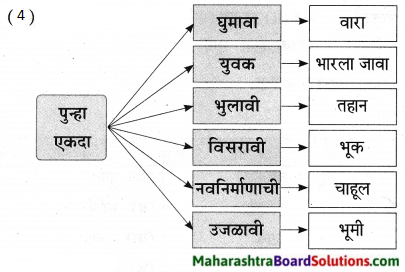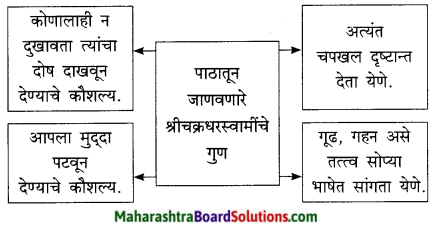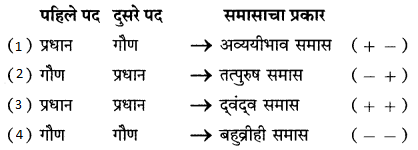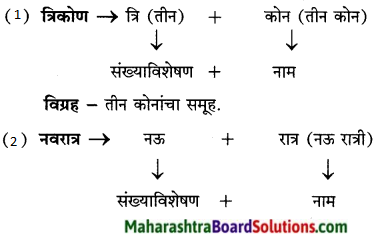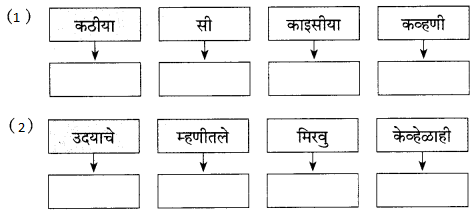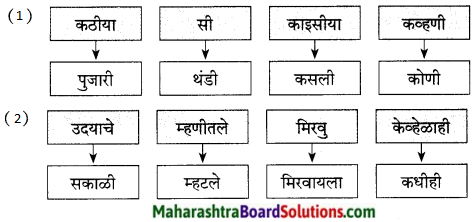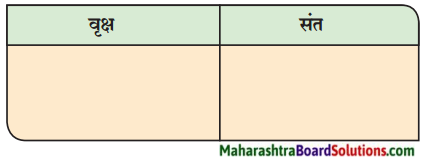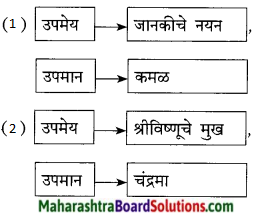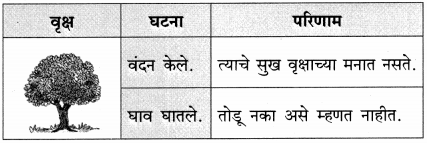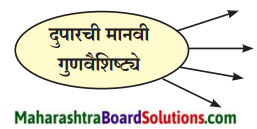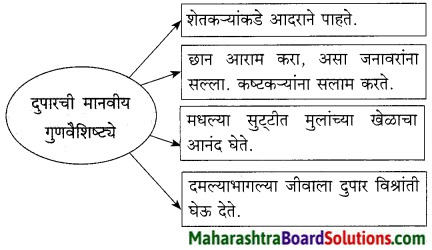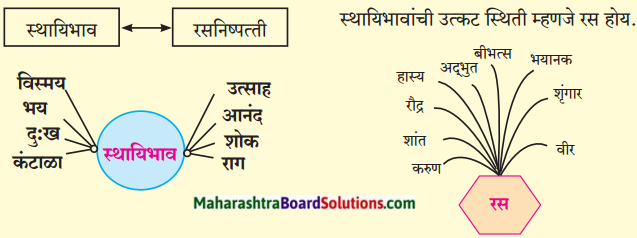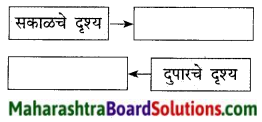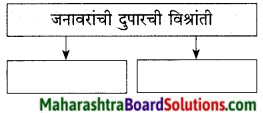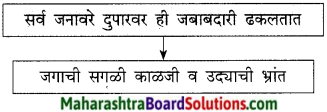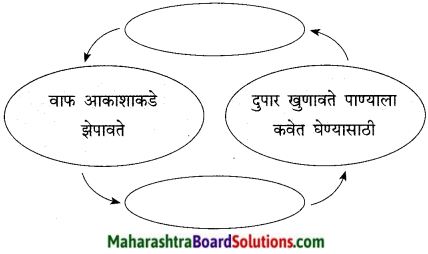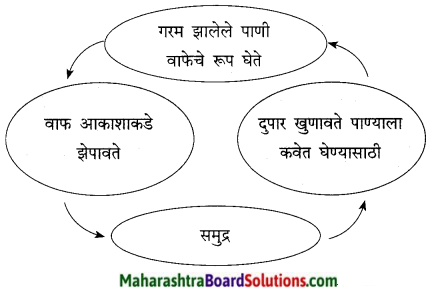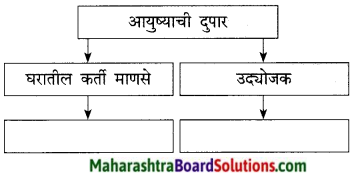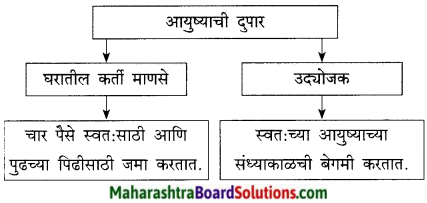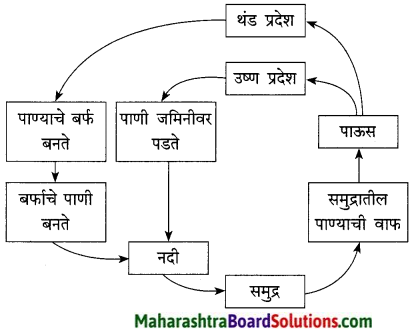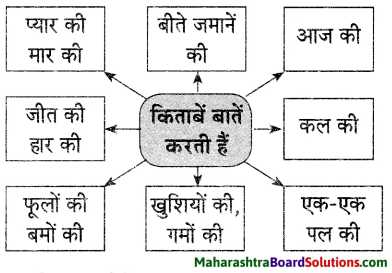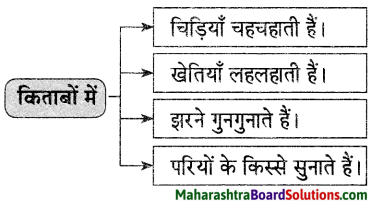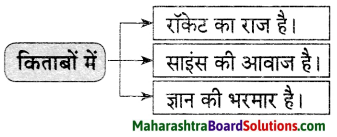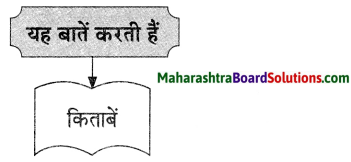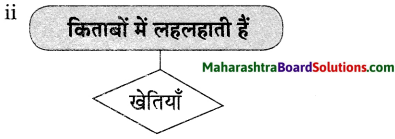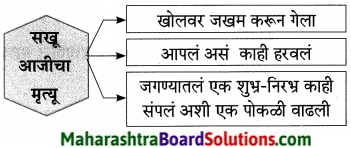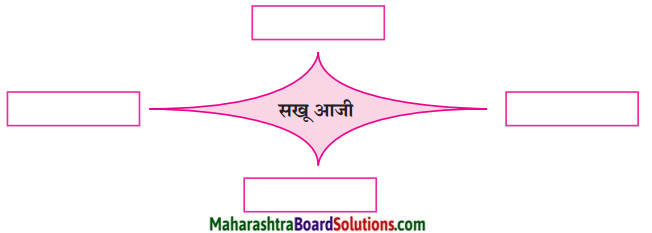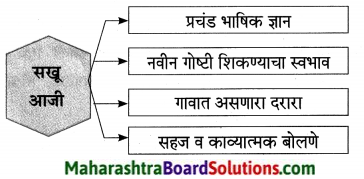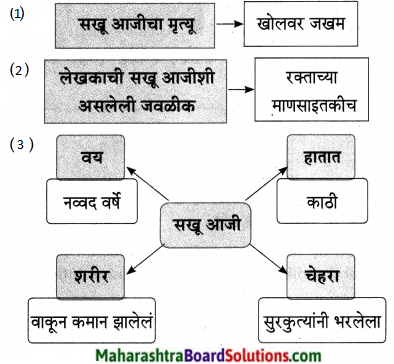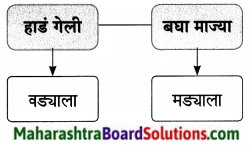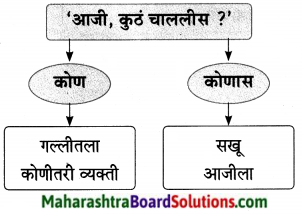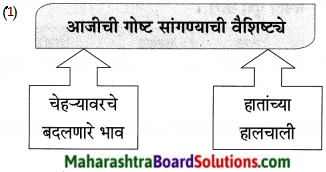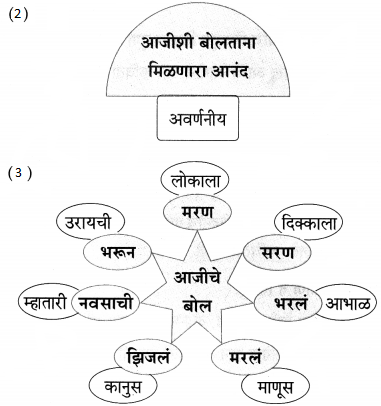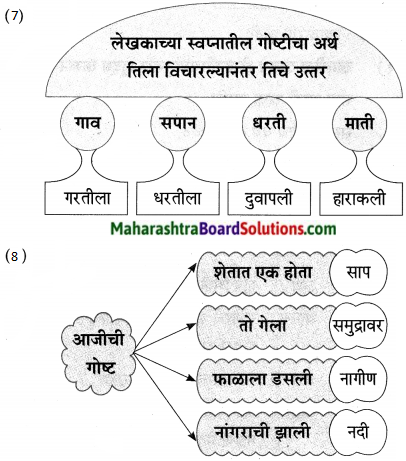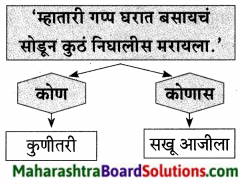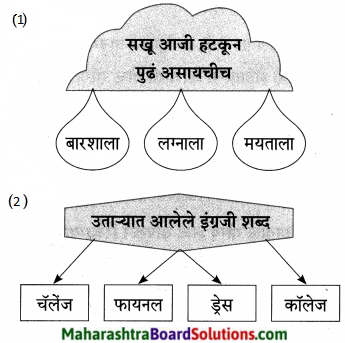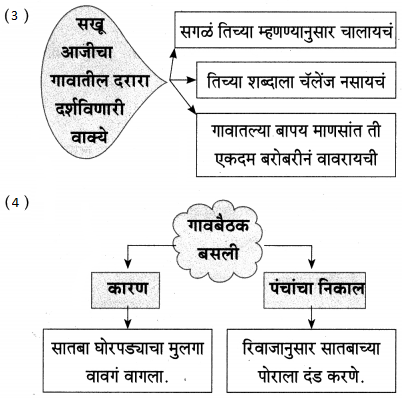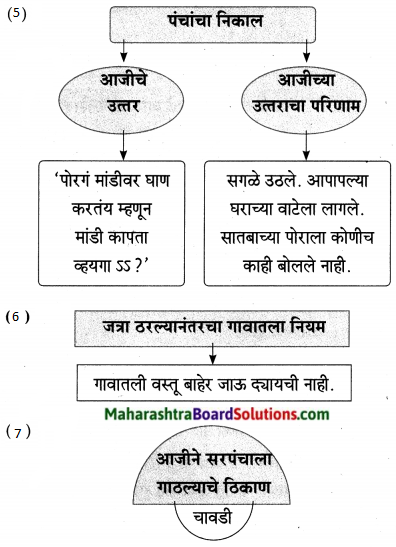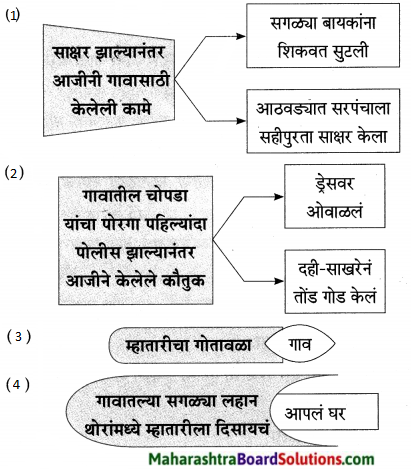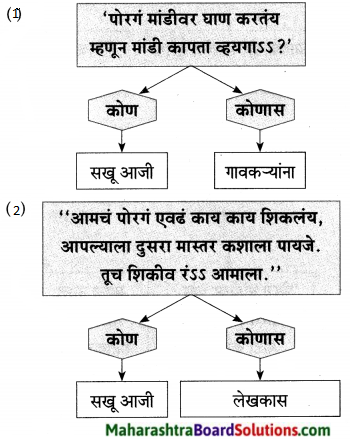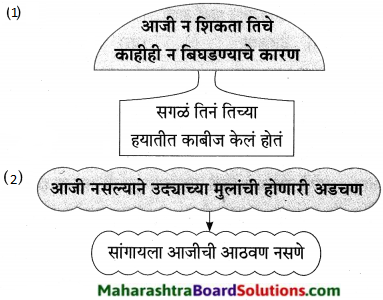Balbharti Maharashtra State Board Class 9 Marathi Solutions Kumarbharti Chapter 8 अभियंत्यांचे दैवत-डॉ. विश्वेश्वरय्या Notes, Textbook Exercise Important Questions and Answers.
Maharashtra State Board Class 9 Marathi Kumarbharti Solutions Chapter 8 अभियंत्यांचे दैवत-डॉ. विश्वेश्वरय्या
9th Std Marathi Kumarbharati Digest Chapter 8 अभियंत्यांचे दैवत-डॉ. विश्वेश्वरय्या Textbook Questions and Answers
1. समर्पक उदाहरण लिहा:
प्रश्न (अ)
विश्वेश्वरय्या यांनी घेतलेले कठोर परिश्रम.
उत्तर:
विश्वेश्वरय्या यांनी स्वत:चे शिक्षण घेण्यासाठी शिकवण्या करून पैसे उभे केले.
प्रश्न (आ)
समर्पक उदाहरण लिहा: माणुसकीचे दर्शन.
उत्तर:
1907 साली विश्वेश्वरय्यांनी स्वेच्छानिवृत्ती घेतली. तत्कालीन मुंबई सरकारने सेवेचा गौरव म्हणून त्यांना पेन्शन दिली. त्या पेन्शनमधे स्वत:च्या गरजेपुरते पैसे ठेवून त्यांनी उरलेली रक्कम गरीब विदयार्थ्यांच्या शिक्षणासाठी व शिक्षणसंस्थांच्या उभारणीसाठी खर्च केली. प्रतिकूल परिस्थितीशी झुंजत शिक्षण घेणाऱ्यांना मदत व्हावी, म्हणून त्यांनी ही देणगी दिली, ही त्यांची, त्यांच्यातील माणुसकीचे दर्शन घडवणारी कृती होय.
![]()
2. खालील प्रत्येक वाक्यातून विश्वेश्वरय्या यांचा कोणता गुण प्रकट होतो ते लिहा:
प्रश्न 1.
खालील प्रत्येक वाक्यातून विश्वेश्वरय्या यांचा कोणता गुण प्रकट होतो ते लिहा:
- आवाजाची लय चुकल्याची जाणीव त्यांना झाली. [ ]
- सफल जीवनासाठी शरीरापेक्षा मनाला महत्त्व देणे. [ ]
- शिकवण्या करून त्यांनी पैसे उभे केले. [ ]
- अभियांत्रिकी पदवी परीक्षेत मुंबई प्रांतात प्रथम आले. [ ]
- वयाच्या नव्वदीतही तरुणांना लाजवेल एवढे उत्साही होते. [ ]
- सारी पेन्शन गरीब विदयार्थ्यांच्या शिक्षणासाठी खर्च केली. [ ]
उत्तर:
- अचूक ज्ञान
- सुखासीनता, विलास यांना महत्त्व न देण्याची वृत्ती.
- कष्टाळूपणा, जिद्द
- बुद्धिमान
- कार्यतत्परता
- सहानुभूती
3. माहिती लिहा
प्रश्न 1.
माहिती लिहा.
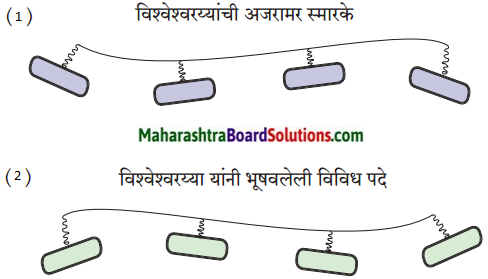
उत्तर:
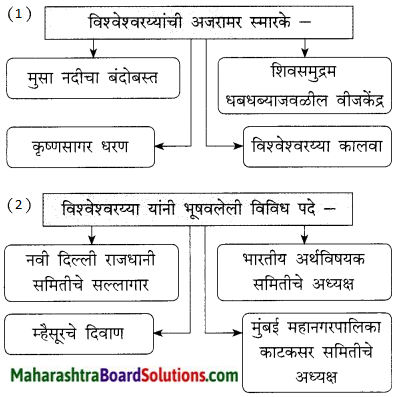
![]()
4. खालील शब्दांच्या अर्थांतील फरक समजून घ्या व त्यांचा स्वतंत्र वाक्यांत उपयोग करा:
प्रश्न 1.
खालील शब्दांच्या अर्थांतील फरक समजून घ्या व त्यांचा स्वतंत्र वाक्यांत उपयोग करा:
(अ) आव्हान – आवाहन
(आ) कृतज्ञ – कृतघ्न
(इ) आभार – अभिनंदन
(ई) विनंती – तक्रार.
उत्तर:
(अ) आव्हान – प्रतिस्पर्ध्याला लढाईला किंवा वादाला बोलावणे.
आवाहन – एखादे चांगले काम करण्यासाठी बोलावणे.
वाक्ये:
आव्हान – भैरू पहिलवानाने कुस्तीसाठी केरू पहिलवानाला आव्हान दिले.
आवाहन – पंतप्रधानांनी जनतेला स्वच्छता अभियानात सामील होण्याचे आवाहन केले.
(आ) कृतज्ञ – उपकाराची जाणीव असणारा.
कृतघ्न – केलेले उपकार विसरणारा.
वाक्ये:
कृतज्ञ – सीमेवर रक्षण करणाऱ्या जवानांबद्दल जनतेने कृतज्ञ राहिले पाहिजे.
कृतघ्न – आपल्याला मदत करणाऱ्यांशी आपण कृतघ्न होऊ नये.
(इ) आभार – धन्यवाद (देणे).
अभिनंदन – शाबासकी (देणे), कौतुक (करणे).
वाक्ये:
आभार – स्नेहसंमेलनाला उपस्थित राहिलेल्या प्रमुख पाहुण्यांचे प्राचार्यांनी आभार मानले.
अभिनंदन – पोहण्याच्या स्पर्धेत मिताली प्रथम आली; म्हणून मॅडमनी तिचे अभिनंदन केले.
(ई) विनंती – विनवणी (करणे).
तक्रार – गा-हाणे (मांडणे).
वाक्ये: विनंती – कार्यक्रमात निवेदकाने अध्यक्षांना स्थानापन्न होण्याची विनंती केली.
तक्रार – सदाशिवरावांनी परिसरातील अस्वच्छतेविषयी आरोग्य अधिकाऱ्यांकडे तक्रार केली.
5. खालील वाक्याचा मराठी भाषेत अनुवाद करा:
प्रश्न 1.
खालील वाक्याचा मराठी भाषेत अनुवाद करा:
He is an engineer of integrity, character and broad outlook.
उत्तर:
ते (विश्वेश्वरय्या) निष्ठावान, चारित्र्यसंपन्न व विशाल दृष्टिकोन असलेले अभियंता आहेत.
![]()
6. स्वमत.
प्रश्न (अ)
विश्वेश्वरय्यांच्या दीर्घ जीवनाच्या पंचसूत्रीतून तुम्हांला होणारा बोध लिहा.
उत्तर:
सुनियंत्रित आचरण, कठोर परिश्रम, प्रसन्नता, संयम व प्रचंड आशावाद ही विश्वेश्वरय्यांच्या दीर्घ जीवनाची पंचसूत्री होती. या सूत्रांना अनुसरून जगल्यास कोणतीही व्यक्ती अत्यंत समाधानी व यशस्वी आयुष्य जगू शकेल.
सुनियंत्रित आचरण म्हणजे कसेही भरकटलेले जीवन न जगता आपल्या ध्येयाला अनुसरून प्रत्येक कृती करणे. त्यासाठी काटेकोर नियोजन केले पाहिजे. कठोर परिश्रमांची तयारी ठेवली पाहिजे. आपले मन आपल्याला सुखासीनतेकडे ओढत राहते. त्याची अजिबात पर्वा करता कामा नये. त्याचबरोबर आपल्या मनाची प्रसन्नता ढळता कामा नये. मन प्रसन्न राखल्यामुळे जीवन जगण्याची शक्ती वाढते. संयम हा सुद्धा एक मोलाचा गुण आहे. अनेक बाबतीत आपले मन अनेक दिशांनी धावते. वासना-विकारांनी प्रभावित होते. अशा वेळी संयमाची नितांत गरज असते. अशा रितीने जगत असताना आपल्या निष्ठा ठाम हव्यात. आपल्या आयुष्यात चांगलेच घडणार, हाती घेतलेले प्रत्येक कार्य यशस्वीच होणार, अशी खात्री बाळगली पाहिजे. हा आशावाद आपल्याला तारून नेतो. विश्वेश्वरय्यांच्या पंचसूत्रीचा हा बोध ध्यानी बाळगल्यास आपले जीवन सुखी, संपन्न होईल.
प्रश्न (आ)
‘स्वप्नातही दिसणार नाही असे जलामृत आपल्या अंगणात आलेले पाहून सक्करकरांच्या डोळ्यांत पाणी आले,’ या वाक्याचा भावार्थ स्पष्ट करा.
उत्तर:
सक्कर या शहरातील नागरिकांना पाणीपुरवठा करण्यासाठी म्हणून नगरपालिकेने सिंधू नदीच्या काठावरील एका डोंगरावर जलाशय बांधला. सिंधू नदीचे पाणी पंपाने उचलून ते जलाशयात साठवले जाऊ लागले. तिथून पाईपांनी सक्करवासीयांना पाणी पुरवले जाऊ लागले. पण घरात पोहोचलेले पाणी वाळूमिश्रित, गढूळ व घाणेरडे होते. जलाशयात जमा होणारे पाणी संपूर्णपणे गाळून शुद्ध करणे आवश्यक होते. मात्र, त्या प्रक्रियेला येणारा खर्च अवाढव्य होता आणि तो नगरपालिकेला झेपणारा नव्हता. म्हणजे नागरिकांच्या नशिबी हेच घाणेरडे पाणी होते.
तेवढ्यात विश्वेश्वरय्यांनी हे आव्हान स्वीकारले. त्यांनी नदीतच विहीर खोदली. नदीचे पात्र व विहिरीचा तळ यांना जोडणारा बोगदा बांधला. मग विहिरीत नैसर्गिक रितीने स्वच्छ झालेले पाणी जमा होऊ लागले. विहिरीतले हे पाणी लोकांना मिळू लागले. हे अमृतासारखे स्वच्छ, शुद्ध पाणी पाहून सक्करकरांचे डोळे आनंदाने पाणावले. अशक्य असलेली गोष्ट विश्वेश्वरय्यांमुळे शक्य झाली, ही कृतज्ञताही त्या अश्रूमध्ये होती.
![]()
प्रश्न (इ)
विश्वेश्वरय्यांमधील तुमच्यावर प्रभाव टाकणाऱ्या गुणविशेषांचे तुमच्या शब्दांत वर्णन करा.
उत्तर:
विश्वेश्वरय्या हे जगद्विख्यात अभियंता होते. अनेक गुणांमुळे ते जागतिक कीर्ती मिळवू शकले. त्यांच्या अनेक गुणांपैकी एक गुण मला खूप आकषून घेतो. समोर उभ्या ठाकलेल्या कोणत्याही समस्येला ते सर्व ताकदीनिशी सामोरे जायला सदोदित तत्पर असत. त्यांचा हा गुण मला खूप आवडतो. त्यांच्या या गुणामुळे त्यांच्याकडे गुंतागुंतीच्या व क्लिष्ट समस्या चालत आल्या. प्रत्येक समस्येच्या सोडवणुकीचा मार्ग भिन्न होता, योजलेले उपाय भिन्न होते. प्रत्येक ठिकाणी केलेले कार्य नावीन्यपूर्ण होते. त्यात त्यांची अभियांत्रिकी प्रतिभा दिसते. सगळी बुद्धी पणाला लावून ते काम करीत. या त्यांच्या गुणामुळेच त्यांच्याकडून अलौकिक कार्ये पार पडली. प्रत्येकाने हा गुण अंगी बाळगला पाहिजे, मग आपापल्या आयुष्यात माणसे यशस्वी होतील. जीवनातला श्रेष्ठ आनंद त्यांना लाभेल.
प्रश्न (ई)
‘झिजलात तरी चालेल पण गंजू नका,’ या विचारातून तुम्हांला मिळालेला संदेश सविस्तर लिहा.
उत्तर:
पंडित जवाहरलाल नेहरू यांनी ‘निष्ठावान अभियंता’ हे उद्गार विश्वेश्वरय्यांना उद्देशून काढले, ते अक्षरशः सत्य आहेत. ते बुद्धिमान होते. त्यांची बुद्धीवर विलक्षण निष्ठा होती. कार्यावर निष्ठा होती. म्हणूनच ते म्हणतात, ‘झिजलात तरी चालेल पण गंजू नका.’ याचा अर्थ स्वत:च्या कार्यासाठी वाटेल ते कष्ट घेण्याची तयारी ठेवली पाहिजे. आराम करण्याची, कष्ट टाळण्याची वृत्ती त्यांना अजिबात मान्य नव्हती. आपण आपले जे कार्यक्षेत्र निवडले आहे, त्यात झोकून दिले पाहिजे. आपली सर्व शक्ती पणाला लावली पाहिजे. मग उत्तुंग यश मिळणारच. सतत काम करीत राहण्याने बुद्धी गंजत नाही. बुद्धी गंजली की माणूस संपलाच. बुद्धी सतत सतेज राखली पाहिजे, हेच विश्वेश्वरय्यांना सांगायचे आहे.
![]()
भाषाभ्यास:
रस म्हणजे चव किंवा रुची. आपण गोड, कडू, आंबट, तिखट, तुरट, खारट असे सहा प्रकारचे रस अनुभवतो. त्याचप्रमाणे काव्याचा आस्वाद घेताना वेगवेगळे रस आपण अनुभवतो. त्यातील भावनांमुळे साधारणपणे नऊ प्रकारचे रस आपल्याला दैनंदिन जीवनात आणि साहित्यात अनुभवायला मिळतात.
| करुण | शोक, दुःख, वियोग, दैन्य, क्लेशदायक घटना. |
| शृंगार | स्त्री-पुरुषांना एकमेकांविषयी वाटणाऱ्या आकर्षणाचे, प्रेमाचे, भेटीची तळमळ, विरह, व्याकुळ मन. |
| वीररस | पराक्रम, शौर्य, धाडस, लढाऊ वृत्ती. |
| हास्य | विसंगती, विडंबन, असंबद्ध घटना, चेष्टा-मस्करी. |
| रौद्र | क्रोधाची तीव्र भावना, निसर्गाचे प्रलयकारी रूप. |
| भयानक | भयानक वर्णने, भीतिदायक वर्णने, मृत्यू, भूतप्रेत, स्मशान, हत्या. |
| बीभत्स | किळस, तिरस्कार जागृत करणाऱ्या भावना. |
| अद्भुत | अद्भुतरम्य, विस्मयजनक, आश्चर्यकारक भावना. |
| शांत | भक्तिभाव व शात स्वरूपातील निसर्गाचे वर्णन. |
रस ही संकल्पना संस्कृत साहित्यातून आलेली आहे. ती शिकवताना प्रामुख्याने कवितांची उदाहरणे दिली जातात. याचा अर्थ रस फक्त काव्यातच असतो असे नाही तर तो सर्व प्रकारच्या साहित्यात असतो. तसेच कधी कधी या नऊ रसांव्यतिरिक्त अनेक वेगवेगळ्या प्रकारच्या भावभावनाही असू शकतात. कोणत्याही साहित्यामध्ये एक किंवा अधिक रस असू शकतात. कवितेतील रस हा विशिष्ट शब्दांत नसतो. उदाहरणार्थ, कवितेत ‘वीर’ हा शब्द आला म्हणजे त्या कवितेत वीररस असेलच असे नाही. तसेच ‘हुंदका’ शब्द आला म्हणजे तिथे करुण रस असेलच असे नाही.
Marathi Kumarbharati Textbook Std 9 Answers Chapter 8 अभियंत्यांचे दैवत-डॉ. विश्वेश्वरय्या Additional Important Questions and Answers
उतारा क्र. 1
पुढील उतारा वाचून दिलेल्या सूचनांनुसार कृती करा:
कृती 2 : (आकलन)
प्रश्न 1.
कोठे ते लिहा:
- वृंदावन उदयान – [ ]
- विश्वेश्वरय्यांच्या पूर्वजांचे गाव – [ ]
- विश्वेश्वरय्यांचे जन्मगाव – [ ]
- विश्वेश्वरय्यांचे अभियांत्रिकी शिक्षण – [ ]
उत्तर:
- म्हैसूर
- मोक्षगुडम
- मदनहळ्ली
- पुणे
प्रश्न 2.
विश्वेश्वरय्यांची पंचसूत्री लिहा.
उत्तर:
- सुनियंत्रित आचरण
- कठोर परिश्रम
- प्रसन्नता
- संयम व
- प्रचंड आशावाद.
![]()
प्रश्न 3.
कारण लिहा:
विश्वेश्वरय्यांचे बालपण व विदयार्थिजीवन कष्टांत गेले.
उत्तर:
विश्वेश्वरय्यांचे बालपण व विदयार्थिजीवन कष्टांत गेले, कारण शालेय शिक्षण घेत असतानाच त्यांचे वडील वारले.
प्रश्न 4.
आकृती पूर्ण करा:

उत्तर:
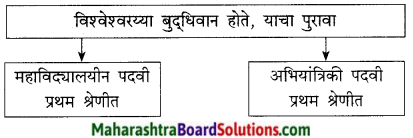
उतारा क्र. 2
पुढील उतारा वाचून दिलेल्या सूचनांनुसार कृती करा:
कृती 1 : (आकलन)
प्रश्न 1.
पुढील वाक्यांतून विश्वेश्वरय्यांचा प्रकट होणारा गुण:
1. नैसर्गिक पद्धतीने विहिरीमध्ये स्वच्छ व शुद्ध पाणी साचू लागले. [ ]
उत्तर:
1. कल्पकता
प्रश्न 2.
माहिती लिहा:
सहायक अभियंता असतानाची विश्वेश्वरय्यांची कामगिरी –
1. …………………………………..
2. …………………………………..
उत्तर:
1. सहायक अभियंता असतानाची विश्वेश्वरय्यांची कामगिरी –
2. खानदेशातील एका नाल्यावर पाईप बसवण्याचे अशक्यप्राय व आव्हानात्मक काम मोठ्या कौशल्याने करून दाखवले.
3. सिंध प्रांतातील सक्कर शहराच्या पाणीपुरवठ्याची क्लिष्ट जबाबदारी यशस्वी रितीने पार पाडली.
![]()
कृती 2 : (आकलन)
प्रश्न 1.
माहिती लिहा:
1. सक्कर शहराच्या पाणीपुरवठ्याची समस्या.
2. सक्करच्या समस्येवर विश्वेश्वरय्यांनी केलेली उपाययोजना.
उत्तर:
1. सक्कर नगरपालिकेने गावाला पाणीपुरवठा करण्यासाठी सिंधू नदीच्या किनाऱ्यावरील डोंगरावर एक जलाशय बांधला. नदीचे पाणी पंपाने उचलून जलाशयात साठवले जाई. तेथून ते सर्व नागरिकांना पुरवले जाई, मात्र, जलाशयात जमा होणारे पाणी वाळूमिश्रित व गढूळ होते. ते तसेच पुरवले जाई. पाणी गाळून स्वच्छ करण्याच्या योजनेकरिता नगरपालिकेकडे पैसा नव्हता. नागरिक जबरदस्त हैराण झाले होते.
2. विश्वेश्वरय्यांनी नदीच्या पात्रातच काठाजवळ एक गोल विहीर खोदली. विहिरीच्या तळापासून नदीच्या प्रवाहाखाली एक बोगदा खणला. त्यामुळे नैसर्गिक पद्धतीनेच स्वच्छ व शुद्ध पाणी विहिरीत साठू लागले. असे स्वच्छ पाणी मिळालेले पाहून सक्करच्या नागरिकांच्या डोळ्यांत आनंदाश्रू आले.
उतारा क्र. 3
1. पुढील उतारा वाचून दिलेल्या सूचनांनुसार कृती करा :
कृती 1 : (आकलन)
प्रश्न 1.
माहिती लिहा:
- तार
- दौरा
- मुसा नदीवरील बंधारा.
उत्तर:
- तार: पूर्वीच्या काळी (जेव्हा फोनसुविधा नव्हती त्या काळी) दूरवर असलेल्या व्यक्तीला तारायंत्राच्या साहाय्याने पाठवला जाणारा तातडीचा संदेश.
- दौरा: विशिष्ट हेतूने किंवा कामासाठी नियोजनपूर्वक केलेला प्रवास.
- मुसा नदीवरील बंधारा: हैदराबादच्या मुसा नदीला एकदा महापूर आला होता. सारे शहरच पाण्याखाली जाण्याचा धोका निर्माण झाला होता.
अशा संकटकाळात विश्वेश्वरय्या धावून आले. मुसा नदीचे खवळलेले पाणी कायमचे आटोक्यात राहील आणि हैदराबाद शहराला कधीही धोका निर्माण होणार नाही, असा पक्का बंदोबस्त विश्वेश्वरय्यांनी त्या काळात केला.
![]()
कृती 2 : (आकलन)
प्रश्न 1.
कोष्टक पूर्ण करा:
| प्रसंग | लोकभावना |
| 1. हैदराबादच्या निजामाची तार : ‘तातडीने या’ | |
| 2. विश्वेश्वरय्यांची विविध संस्थांच्या अध्यक्षपदांवर नेमणूक |
उत्तर:
| प्रसंग | लोकभावना |
| 1. हैदराबादच्या निजामाची तार : ‘तातडीने या’ | 1 संकटात विश्वेश्वरय्यांचा आधार वाटतो. |
| 2. विश्वेश्वरय्यांची विविध संस्थांच्या अध्यक्षपदांवर नेमणूक | 2. विश्वेश्वरय्यांच्या मोठ्या कर्तबगारीवर विश्वास |
प्रश्न 2.
आकृती पूर्ण करा:
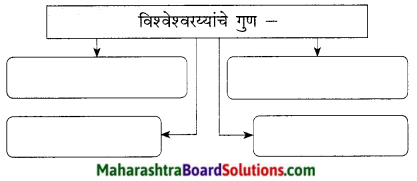
उत्तर:
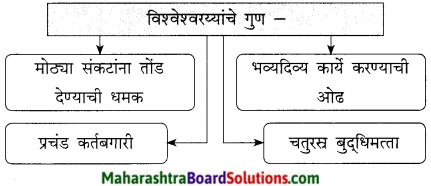
कृती 3 : (स्वमत/अभिव्यक्ती)
प्रश्न 1.
विश्वेश्वरय्यांनी बांधलेल्या कावेरी नदीवरील ‘कृष्णसागर’ या धरणाचा अजस्रपणा स्पष्ट करा.
उत्तर:
म्हैसूर संस्थानच्या महाराजांनी विश्वविश्वेश्वरय्यांचे गुण विश्वरय्यांना आपल्या संस्थानात मुख्य अभियंता या पदावर नेमले. आपल्या कारकिर्दीच्या सुरुवातीलाच त्यांनी ‘कृष्णसागर’ हे अजस्र धरण बांधले. या अजस्र धरणामुळे जगभर त्यांचे कौतुक झाले.
हे धरण होतेच मुळी तसे. 8600 फूट लांब, 101 फूट रुंद व 104 फूट उंच! धरणाच्या माथ्यावर 50 फूट रुंदीचा मोटर रस्ता. धरणातील पाणी सोडण्यासाठी तब्बल 179 दरवाजे होते! आपोआप उघडझाप करणारे. धरणाच्या बाजूला 60 मैल लांबीचा कालवा काढलेला आहे. तो कालवा ‘विश्वेश्वरय्या कालवा’ या नावाने गौरवला जातो. या कालव्यासाठी 3960 फूट लांबीचा बोगदा तयार केलेला आहे. या धरणातून ठरावीक पाणी शिवसमुद्रम धबधब्यात सोडतात आणि त्याआधारे एक वीजनिर्मिती केंद्र चालवले जाते. या विजेच्या बळावर म्हैसूरचा राजवाडा व वृंदावन उदयान रोषणाईने झळझळतात. विश्वेश्वरय्यांच्या अभियांत्रिकी करामतीची ही स्मारकेच होत.
![]()
उतारा क्र. 4
1. पुढील उतारा वाचून दिलेल्या सूचनांनुसार कृती करा:
कृती 1 : (आकलन)
प्रश्न 1.
पुढील वाक्यांतून विश्वेश्वरय्यांचा प्रकट होणारा गुण:
1. झिजलात तरी चालेल, पण गंजू नका.
उत्तर:
1. बुद्धीवरील निष्ठा
कृती 2 : (आकलन)
प्रश्न 1.
आकृती पूर्ण करा:

उत्तर:

प्रश्न 2.
माहिती लिहा:
विश्वेश्वरय्यांची उभारलेली स्मारके:
उत्तर:
1. त्यांच्या जन्मगावी एका भव्य उदयानात त्यांचा पुतळा उभारला गेला आहे.
2. त्यांनी स्वतः बांधलेले त्यांचे सुंदर घर ‘राष्ट्रीय स्मारक’ म्हणून जाहीर.
![]()
भाषाभ्यास:
(अ) व्याकरण घटकांवर आधारित कृती :
1. समास:
प्रश्न 1.
पुढील विग्रहांवरून समास ओळखा:
- पाप किंवा पुण्य → ………………..
- खाणे, पिणे वगैरे → ……………….
- महान असे राष्ट्र → ………………..
- नवरा आणि बायको → ……………
- तीन खंडांचा समूह → …………….
उत्तर:
- वैकल्पिक द्वंद्व समास
- समाहार वंद्व समास
- कर्मधारय समास
- इतरेतर द्वंद्व समास
- द्विगू समास.
2. शब्दसिद्धी:
प्रश्न 1.
‘अति’ उपसर्ग असलेले चार शब्द लिहा.
उत्तर:
- अतिमंद
- अत्यानंद (अति + आनंद)
- अतिविचारी
- अतिहुशार.
3. वाक्प्रचार/म्हणी:
प्रश्न 1.
पुढील वाक्प्रचारांचा अर्थ सांगून वाक्यांत उपयोग करा:
1. चकित होणे
2. मार्गदर्शन करणे.
उत्तर:
1. चकित होणे – अर्थ : आश्चर्य वाटणे.
वाक्य : तीन वर्षांच्या बाळूने सुरेख चित्र काढलेले पाहिल्यावर सगळे चकित झाले.
2. मार्गदर्शन करणे – अर्थ : योग्य दिशा दाखवणे.
वाक्य : शालान्त परीक्षेत माझ्या दादाने मला मार्गदर्शन केले.
![]()
प्रश्न 2.
म्हणी पूर्ण करा:
1. ……………………. काकडीला राजी. (कोल्हा/ लांडगा)
2. …………………… गुळाची चव काय? (गाढवाला/घोड्याला)
उत्तर:
1. कोल्हा काकडीला राजी.
2. गाढवाला गुळाची चव काय?
(आ) भाषिक घटकांवर आधारित कृती:
प्रश्न 1.
विरुद्धार्थी शब्दांच्या जोड्या जुळवा:

उत्तर:
- पूर्वज × वंशज
- निवृत्ती × प्रवृत्ती
- सफल × विफल
- उंच × सखोल
2. लेखननियम:
प्रश्न 1.
अचूक शब्द ओळखा:
- सूसंस्कृत, सुंसस्कृत, सुसंस्कृत, सुसंक्सृत.
- फलश्रूती, फलश्रुती, फळधृति, फलश्रुति.
- कुतूहल, कुतुहल, कुतुहल, कूतूहल.
- नीयूक्त, नियूक्त, नियुत्क, नियुक्त.
- प्रोत्साहन, प्रोत्साहण, प्रोस्ताहण, प्रोत्सहन.
- कामगीरी, कामगिरी, कामगिरि, कामगीरि.
उत्तर:
- सुसंस्कृत
- फलश्रुती
- कुतूहल
- नियुक्त
- प्रोत्साहन
- कामगिरी.
![]()
3. विरामचिन्हे:
प्रश्न 1.
पुढील वाक्यांतील विरामचिन्हे ओळखा:
1. विश्वेश्वरय्यांचा जन्मदिन ‘अभियंता दिन’ म्हणून साजरा होतो.
2. परिस्थिती बेताची होती; पण आई मनाची श्रीमंत होती, जिद्दी होती.
उत्तर:
1. एकेरी अवतरणचिन्ह व पूर्णविराम.
2. अर्धविराम, स्वल्पविराम व पूर्णविराम.
4. पारिभाषिक शब्द:
प्रश्न 1.
मराठी प्रतिशब्द लिहा:
- Exhibition
- Receptionist
- Handbill
- Goodwill
उत्तर:
- प्रदर्शन
- स्वागतिका
- हस्तपत्रक
- सदिच्छा.
अभियंत्यांचे दैवत-डॉ. विश्वेश्वरय्या Summary in Marathi
प्रस्तावना:
डॉ. यशवंत पाटणे हे प्रसिद्ध लेखकांपैकी एक आहेत. त्यांची अनेक पुस्तके प्रसिद्ध झाली आहेत. माणसाने स्वत:च्या सुखाकडे पाहावे, हे ठीक आहे. पण त्याबरोबरच स्वत:पलीकडे, समाजाकडे पाहिले पाहिजे. समाजाच्या भल्यासाठी काहीतरी केले पाहिजे. ते माणसाचे कर्तव्य आहे, असा लेखकांचा दृष्टिकोन आहे. म्हणूनच त्यांना विश्वेश्वरय्यांसारखे निष्ठावान कर्मयोगी भावतात. त्यांच्या कार्याने ते स्वतः प्रभावित होतात. प्रस्तुत पाठात लेखकांनी विश्वेश्वरय्यांचे कार्यकर्तृत्व वर्णन केले आहे.
विश्वेश्वरय्यांनी त्यांच्या काळात समोर उभ्या ठाकलेल्या जटिल समस्या सोडवल्या. त्यांचे प्रयत्न म्हणजे केवळ स्वत:ची बुद्धिमत्ता सिद्ध करण्यासाठी केलेली कृती नव्हती. त्यांच्यासमोर लोकांच्या समस्या सोडवण्याचे आव्हान होते. आपले ज्ञान, आपली कर्तबगारी समाजाच्या कल्याणासाठी वापरली गेली पाहिजे, ही त्यांची भूमिका होती. या पाठात वर्णन केलेली त्यांची कार्ये ही त्यांच्या भूमिकेचाच परिपाक होती. त्यांनी आपले दीर्घायुष्य या त-हेने माणसाच्या कल्याणासाठी वापरले, हेच या पाठातून लेखकांनी दाखवून दिले आहे.
![]()
शब्दार्थ:
- नियंता – नियंत्रक.
- विश्वात्मकता – विश्वाला व्यापून टाकण्याची वृत्ती.
- क्लिष्ट – गुंतागुंतीची.
- कारकीर्द – केलेल्या कार्याचा काळ.
वाक्प्रचार व त्यांचे अर्थ:
1. आव्हान स्वीकारणे – एखादे कार्य पार पाडण्यास सिद्ध होणे.
2. रौद्ररूप धारण करणे – भीतिदायक स्थिती निर्माण होणे.


